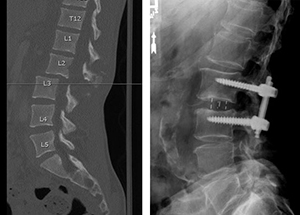
Treating patients with traumatic spinal cord injuries has significant challenges, in large part because of the potentially severe and life-altering effects these injuries can have. Despite recent progress in finding the best way to treat spinal cord damage, many patients are left with profound disabilities. Additional research, both in the lab and the clinic, is vital.
At Brigham and Women’s Hospital, physicians and scientists are making advances on several fronts. From the time patients with these injuries are brought into the Emergency Department, experts in trauma and critical care medicine collaborate with spine surgeons, neurologists and other specialists to address the most immediate complications and do everything possible to ensure the best long-term outcomes.
“The Brigham has an experienced and efficient ED system, and when a patient comes in with a traumatic spine injury, the first thing we look at is ABC — airway, breathing and circulation,” said Yi Lu, MD, PhD, director of neurological trauma and co-director of the Brigham’s Adult Spinal Deformity and Scoliosis Program. “At the same time, there have been quite a few studies showing that if the spinal cord can be decompressed and stabilized within the first 24 hours, the outcomes are much better.”
Dr. Lu added that even though some of these surgeries are quite complex, the team at the Brigham always strives to bring these patients in to the operating room as quickly as possible to maximize their likelihood of a functional recovery.
Exploring New Interventions to Repair Nerve Damage
Beyond surgery, a number of medical interventions are being explored to improve patient outcomes, including drugs, cell-based therapies and biomaterials and neural scaffolds. Dr. Lu and other Brigham investigators are studying many of these approaches in the lab in cell and animal models.
Corticosteroids were once considered promising for reducing long-term damage, but research revealed these drugs tend to do more harm than good. Similarly, other therapeutic agents, including GM-1 ganglioside and rho kinase inhibitors, have had clinical trials discontinued after failing to show benefit.
Other medical interventions, however, have shown promise and continue to be studied. These include riluzole, a sodium channel inhibitor currently approved to treat ALS, the antibiotic minocycline and granulocyte colony-stimulating factor, all of which are being tested in later-stage clinical trials.
Stem cell-based therapies are also considered a promising avenue for repairing damaged nerve connections. However, more research is needed to determine the best subtype of stem cells and how to use them. Likewise, the use of neuro-spinal scaffolds are being studied as a way to promote neuronal growth. A clinical trial looking at this approach is underway at the Brigham.
In addition to these medical treatments, research is looking at technological interventions such as neuromodulation and brain-computer interfaces. “Spinal cord stimulators combined with extensive physical therapy have shown improvements in functional outcomes,” Dr. Lu said. “Brain-machine interfaces that bypass the injury site may also help patients’ functional outcomes.”
A Team-Based Approach to Care
Dr. Lu said that the Brigham’s expertise extends far beyond treatment of the injury itself. “Many of these patients require extensive and meticulous care in the intensive care unit,” he said. “From head to toe, every single system in the body can be affected by spinal cord injury.”
He credits the Brigham’s nursing team with making sure patients’ needs are addressed. This includes tackling not only blood pressure and breathing problems that can occur as a direct result of injury, but also preventing and treating other longer-term issues that can arise in patients who are paralyzed, such as aspiration pneumonia, bed sores and urinary tract problems like retention.
Dr. Lu noted that physical therapists, including those at Spaulding Rehabilitation Hospital, where the majority of the Brigham’s spinal cord injury patients go after being discharged, also play a vital role. Spaulding Rehabilitation Hospital is a Harvard Medical School-affiliated hospital that’s part of the Mass General Brigham healthcare system (formerly known as Partners HealthCare).
“Physical therapy is a very important part of recovery, if not the most important part,” he said. “Close interaction between our team and the physicians and therapists at Spaulding ensure our patients are well taken care of and have the best recovery possible. We, and our patients, are fortunate to have this relationship.”
New Spine Center: A Multidisciplinary, Integrated Care Model
Brigham and Women’s Spine Center is a new service line committed to high-quality care that is carried throughout each patient experience by a team of renowned experts in spine conditions including Harvard Medical School-appointed neurosurgeons, orthopaedic surgeons, pain medicine specialists, physical medicine and rehabilitation specialists, advanced practitioners and other clinical staff.
Our team of specialists offer a range of personalized treatment options to help patients regain function, such as:
- Rehabilitation solutions, including physical therapy or occupational therapy
- Minimally invasive interventional treatments, including injections or medications
- Surgical treatments including spinal decompression, spinal fusion or spinal reconstruction
Our multidisciplinary team advocates for each patient’s best interest and customizes care recommendations to meet individual goals.